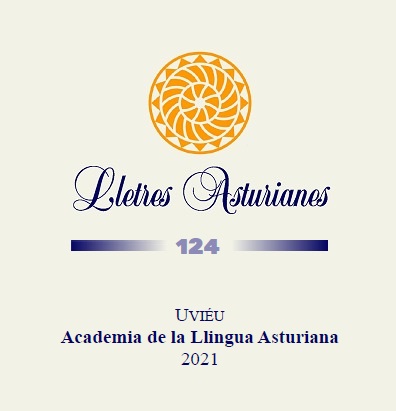Resumen
Les construcciones mediopasives son predicaos xenéricos que describen propiedaes intrínseques d’un oxetu nocional, realizáu como suxetu gramatical en posición preverbal. Una de les carauterístiques asociaes polo xeneral a esti tipu d’estructures a nivel interllingüísticu ye la participación d’un axente implícitu nel eventu. D’acordies con Suárez-Palma (2019; 2020), propónse qu’ello ye debío a la presencia d’un sintagma Voz (SVoz) pasivizáu per aciu del pronome reflexivu se nestes oraciones, lo mesmo en castellán que n’asturianu. Estes estructures, amás, permiten l’inxerimientu d’un argumentu adicional con casu dativu, interpretáu como afeutáu pol resultáu final del oxetu nocional. Siguiendo a Cuervo (2003) y Pylkkänen (2008), esplícase qu’un sintagma aplicativu (SApl) inxer esti argumentu na derivación al amestase per debaxo del SVoz. Asina mesmo, úfrense datos que demuestren que les medio pasives tán suxetes a variación morfosintáutica nestes dos llingües. D’esta miente, espónse que’l castellán cuenta amás con una construcción homófona, anque ensin SVoz –y darréu d’ello non axentiva– qu’espresa camudamientu d’estáu xenéricos y espontanios. El pronome reflexivu nesta variante incoativa sedría la forma fonética d’un subeventu de camudamientu (vGO, según Cuervo (2003)). Contrariamente, l’asturianu, que dispón tamién de la variante non axentiva de la mediopasiva, prescinde del reflexivu nestos contestos porque vGO nun tien conteníu fonéticu nesta llingua. Curiosamente, los argumentos adicionales dativos nes versiones incoatives puen interpretase como de causantes accidentales del eventu. Ello ye debío a que’l SApl ocupa’l llugar que dexa llibre’l SVoz na derivación. A lo cabero, incídese na falta d’una clasificación dafechu de les mediopasivesnes dos llingües.
Pallabres clave: mediopasives, alternancia causativa, dativos, argumentos implícitos, variación morfosintáutica.
Citas
Ackema, P. & Schoorlemmer, M. (1994). The middle construction and the syntax-semantics interface. Lingua, 93(1), 59-90. DOI: 10.1016/0024-3841(94)90353-0.
Ackema, P. & Schoorlemmer, M. (1995). Middles and nonmovement. Linguistic Inquiry, 26(2), 173-197.
ALLA (20013). Gramática de la Llingua Asturiana. Uviéu: Academia de la Llingua Asturiana.
Bosque, I. & Demonte, V. (1999). Gramática descriptiva de la lengua española. Madrid: Espasa.
Chierchia, G. (2003). A semantics for unaccusatives and its syntactic consequences. En A. Alexiadou, E. Anagnostopoulou & M. Everaert (eds.), The Unaccusativity Puzzle. Explorations of the Syntax-lexicon Interface (pp. 60-84). Oxford: Oxford University Press.
Chomsky, N. (1995). The Minimalist Program. Cambridge, MA: MIT Press.
Contreras, H. (1976). A theory of word order with special reference to Spanish. Amsterdam: North-Holland.
Cuervo, M. C. (2003). Datives at large. (Tesis doctoral), Instituto Tecnológico de Massachusetts, Cambridge MA.
Dixon, R. M.W. (1982). Where have all the adjectives gone? And other essays in semantics and syntax. Janualinguarum. Series Maior, 107. Berlin: Mouton.
Fagan, S. (1992). The syntax and semantics of middle constructions: A study with special reference to German. Cambridge: Cambridge University Press.
Folli, R. & Harley, H. (2004). Flavor of v. Consuming results in Italian and English. En R. Slabakoba & P. Kempchinsky (eds.), Aspectual Inquiries (pp. 95-120). Dordrecht: Kluwer.
Gili Gaya, S. (1943). Curso superior de sintaxis española. Barcelona: Vox.
Hale, K. & Keyser, S. J. (1986). Some transitivity alternations in English. Anuario del Seminario de Filología Vasca «Julio de Urquijo», 20(3), 605-638.
Harley, H. (2014). On the identity of roots. Theoretical Linguistics, 40(3), 225-276.
Hoekstra, T. & Roberts, I. (1993). Middle constructions in Dutch and English. En E. Reuland & Abraham, W. (eds.), Knowledge and Language (Volume II: Lexical and Conceptual Structure, pp. 183-220). Dordrecht: Kluwer.
Kempchinsky, P. (2006). Teasing apart the middle. En I. Laka & B. Fernández (eds.), Andolingogoan/Homenaje a AndolinEguzkitza (pp. 532-547). Leioa: Universidad del País Vasco.
Kratzer, A. (1996). Severing the external argument from its verb. En J. Rooryck& L. Zaring (eds.), Phrase structure and the lexicon (pp. 109-137). Springer: Dordrecht. DOI: 10.1007/978-94-015-8617-7_5.
Marantz, A. (1984). On the nature of grammatical relations. Linguistic Inquiry Monographs. Volume 10. Cambridge, MA: MIT Press.
Mendikoetxea, A. (1999). Construcciones con «se»: medias, pasivas e impersonales. En I. Bosque & V. Demonte (eds.), Gramática descriptiva de la lengua española (pp. 1575-1630). Madrid: Espasa Calpe.
Keyser, S. J. & Roeper, Th. (1984). On the middle and ergative constructions in English. Linguistic Inquiry, 3, 381-416.
Levin, B. & Rappaport-Hovav, M. (1995). Unaccusativity at the syntax-lexical semantics interface. Cambridge, MA: MIT Press.
Olarrea, A. (1996). Pre and postverbal subject positions in Spanish: a minimalist account. (Tesis doctoral), Universidad de Washington, Seattle WA.
Omori, Y. (1997). Ambiguity in the constructions with se. Sophia Lingüística, 41, 115-131.
Ordóñez, F. & E. Treviño (1999). Left dislocated subjects and the pro-drop parameter: a case study of Spanish. Lingua, 107, 39-68. DOI: 10.1016/S0024-3841(98)00020-5.
Pylkkänen, L. (2008). Introducing arguments. Linguistic Inquiry Monographs, Volume 49. Cambridge MA: MIT Press.
Rivero, M. L. (1980). On left-dislocation and topicalization in Spanish. Linguistic Inquiry, 11, 363-393.
Roberts, I. (1987). The Representation of Implicit and Dethematized Subjects. Dordrecht: Foris.
Sánchez López, C. (2002). Las construcciones con se. Estado de la cuestión. En C. Sánchez López (ed.), Las construcciones con se. Madrid: Visor Libros.
Schäfer, F. (2008). The syntax of (anti-) causatives: External arguments in change-of-state contexts, Volume 126. Amsterdam: John Benjamins Publishing.
Stroik, Th. (1992). Middles and movement. Linguistic Inquiry, 23(1), 127-137.
Stroik, Th. (1995). On middle formation: A reply to Zribi-Hertz. Linguistic Inquiry, 26(1), 165-171.
Stroik, Th. (1999). Middles and reflexivity. Linguistic Inquiry, 30(1), 119-131.
Suárez-Palma, I. (2019). Stuck in the Middle: Dative arguments and middle-passive constructions in Spanish. (Tesis doctoral), Universidad de Arizona, Tucson AZ.
Suárez-Palma, I. (2020). Applied arguments in Spanish inchoative middle constructions. Glossa: a journal of general linguistics, 5(1): 9, 1-37. DOI: https//doi.org/10.5334/gjgl.827.
Suñer, M. (1982). Syntax and Semantics of Spanish Presentational Sentence-Types. Washington DC: Georgetown University Press.
Zribi-Hertz, A. (1993). On Stroik's analysis of English middle constructions. Linguistic Inquiry, 24(3), 583-589.

